Page 13 of 348
INTERIOR
Interior
1 — Window Switches3 — Gear Selector
2 — Seats 4 — Glove Compartment
2
GRAPHICAL TABLE OF CONTENTS 11
Page 15 of 348
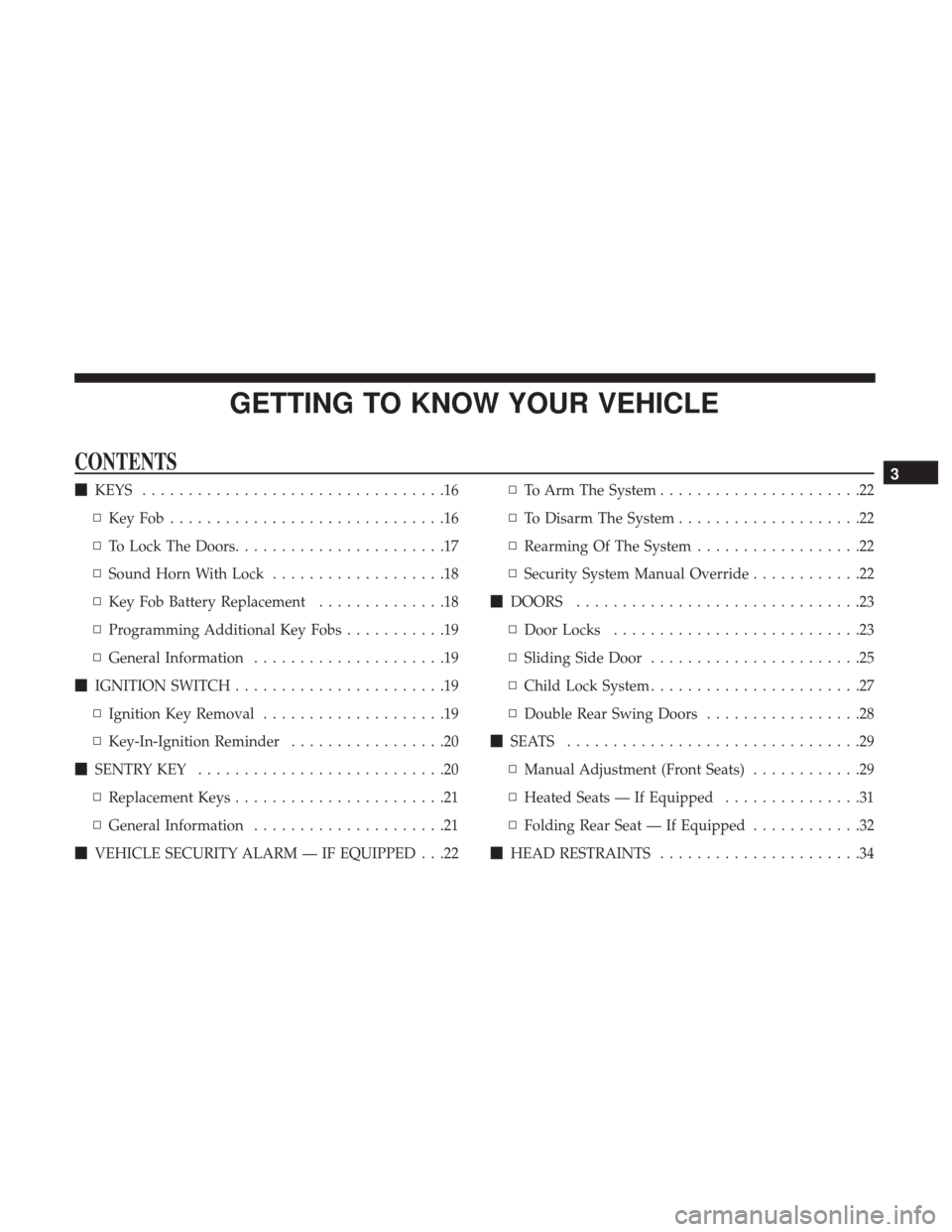
GETTING TO KNOW YOUR VEHICLE
CONTENTS
�KEYS .................................16
▫ KeyFob..............................16
▫ To Lock The Doors .......................17
▫ Sound Horn With Lock ...................18
▫ Key Fob Battery Replacement ..............18
▫ Programming Additional Key Fobs ...........19
▫ General Information .....................19
� IGNITION SWITCH .......................19
▫ Ignition Key Removal ....................19
▫ Key-In-Ignition Reminder .................20
� SENTRY KEY ...........................20
▫ Replacement Keys .......................21
▫ General Information .....................21
� VEHICLE SECURITY ALARM — IF EQUIPPED . . .22 ▫
To Arm The System ......................22
▫ To Disarm The System ....................22
▫ Rearming Of The System ..................22
▫ Security System Manual Override ............22
� DOORS ...............................23
▫ Door Locks ...........................23
▫ Sliding Side Door .......................25
▫ Child Lock System .......................27
▫ Double Rear Swing Doors .................28
� SEATS ................................29
▫ Manual Adjustment (Front Seats) ............29
▫ Heated Seats — If Equipped ...............31
▫ Folding Rear Seat — If Equipped ............32
� HEAD RESTRAINTS ......................343
Page 30 of 348
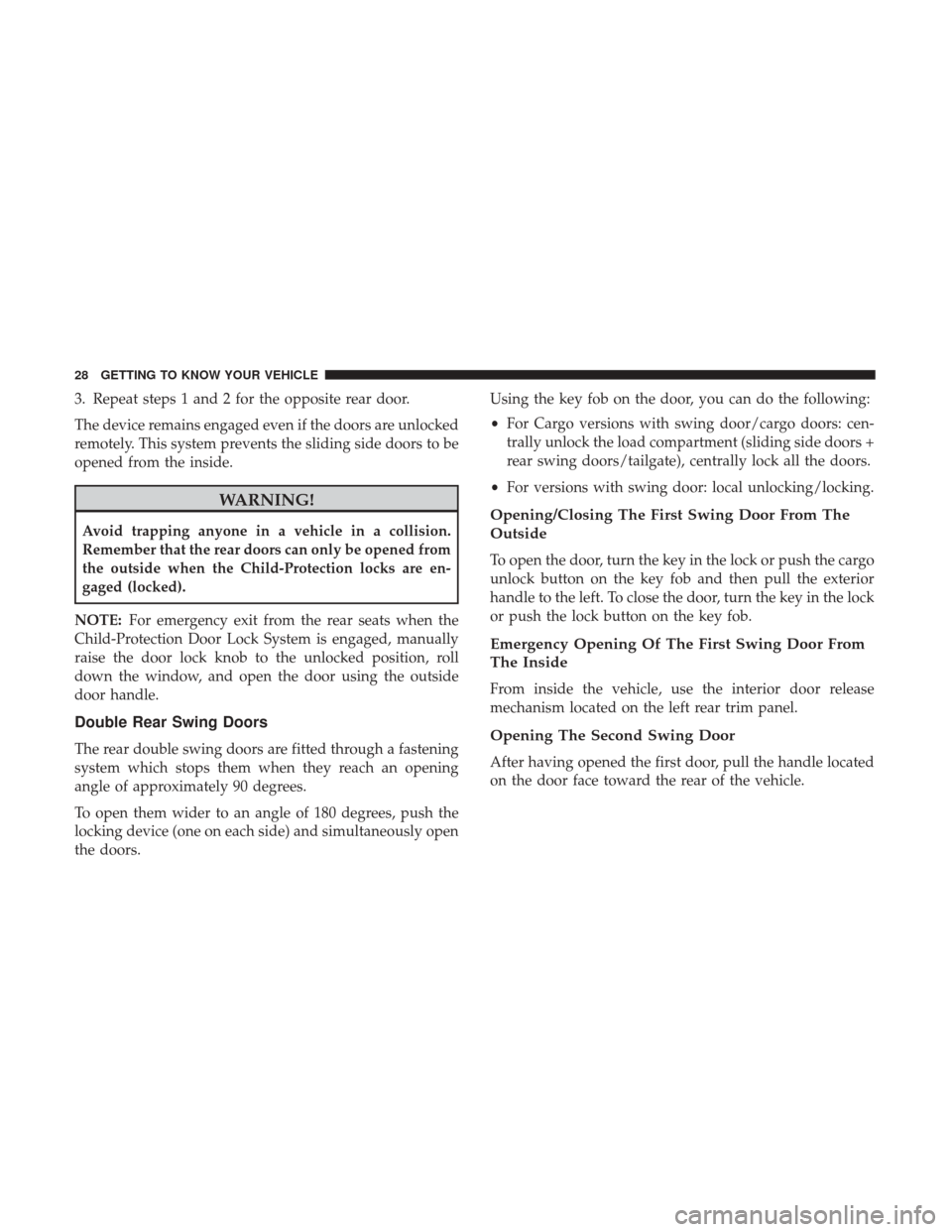
3. Repeat steps 1 and 2 for the opposite rear door.
The device remains engaged even if the doors are unlocked
remotely. This system prevents the sliding side doors to be
opened from the inside.
WARNING!
Avoid trapping anyone in a vehicle in a collision.
Remember that the rear doors can only be opened from
the outside when the Child-Protection locks are en-
gaged (locked).
NOTE: For emergency exit from the rear seats when the
Child-Protection Door Lock System is engaged, manually
raise the door lock knob to the unlocked position, roll
down the window, and open the door using the outside
door handle.
Double Rear Swing Doors
The rear double swing doors are fitted through a fastening
system which stops them when they reach an opening
angle of approximately 90 degrees.
To open them wider to an angle of 180 degrees, push the
locking device (one on each side) and simultaneously open
the doors. Using the key fob on the door, you can do the following:
•
For Cargo versions with swing door/cargo doors: cen-
trally unlock the load compartment (sliding side doors +
rear swing doors/tailgate), centrally lock all the doors.
• For versions with swing door: local unlocking/locking.
Opening/Closing The First Swing Door From The
Outside
To open the door, turn the key in the lock or push the cargo
unlock button on the key fob and then pull the exterior
handle to the left. To close the door, turn the key in the lock
or push the lock button on the key fob.
Emergency Opening Of The First Swing Door From
The Inside
From inside the vehicle, use the interior door release
mechanism located on the left rear trim panel.
Opening The Second Swing Door
After having opened the first door, pull the handle located
on the door face toward the rear of the vehicle.
28 GETTING TO KNOW YOUR VEHICLE
Page 31 of 348
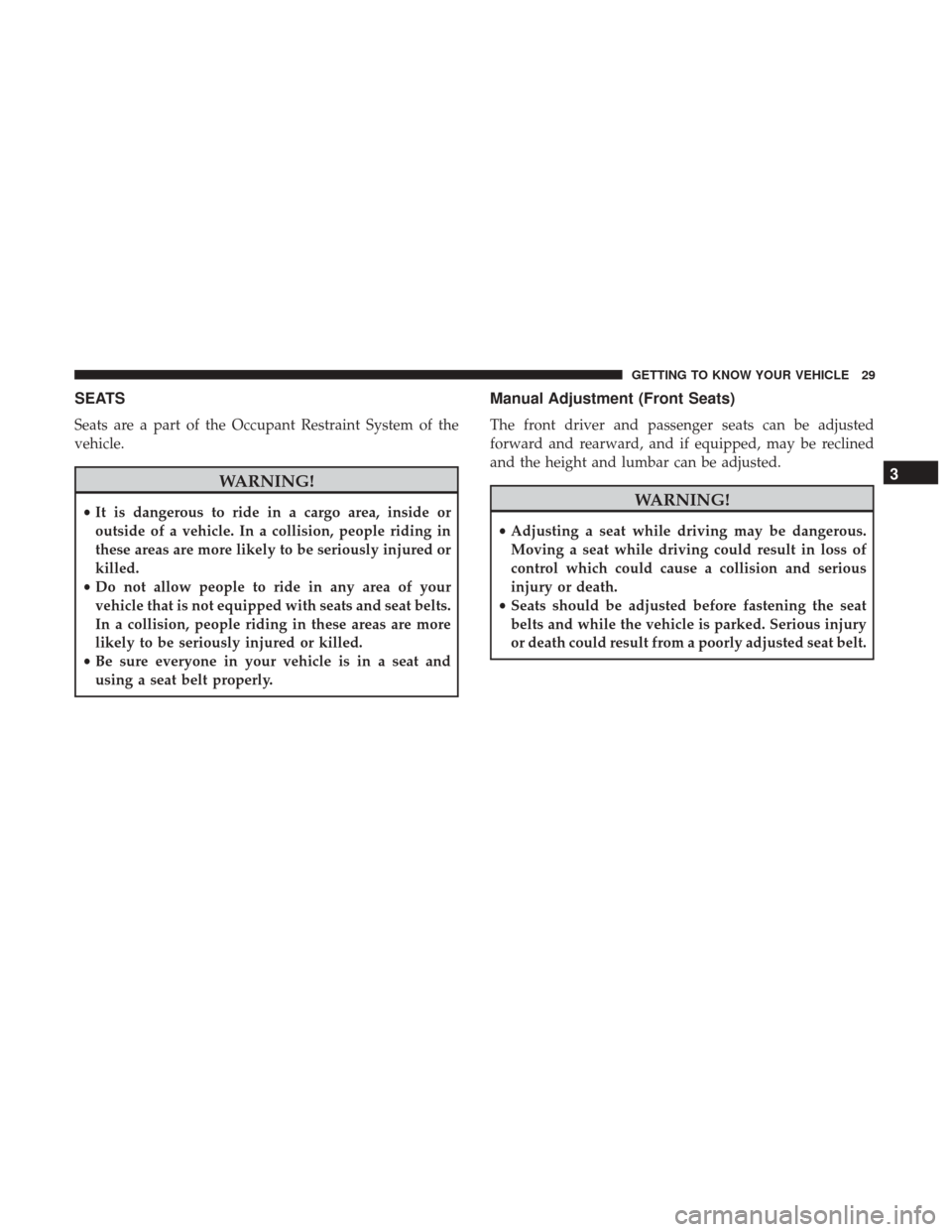
SEATS
Seats are a part of the Occupant Restraint System of the
vehicle.
WARNING!
•It is dangerous to ride in a cargo area, inside or
outside of a vehicle. In a collision, people riding in
these areas are more likely to be seriously injured or
killed.
• Do not allow people to ride in any area of your
vehicle that is not equipped with seats and seat belts.
In a collision, people riding in these areas are more
likely to be seriously injured or killed.
• Be sure everyone in your vehicle is in a seat and
using a seat belt properly.
Manual Adjustment (Front Seats)
The front driver and passenger seats can be adjusted
forward and rearward, and if equipped, may be reclined
and the height and lumbar can be adjusted.
WARNING!
• Adjusting a seat while driving may be dangerous.
Moving a seat while driving could result in loss of
control which could cause a collision and serious
injury or death.
• Seats should be adjusted before fastening the seat
belts and while the vehicle is parked. Serious injury
or death could result from a poorly adjusted seat belt.
3
GETTING TO KNOW YOUR VEHICLE 29
Page 33 of 348
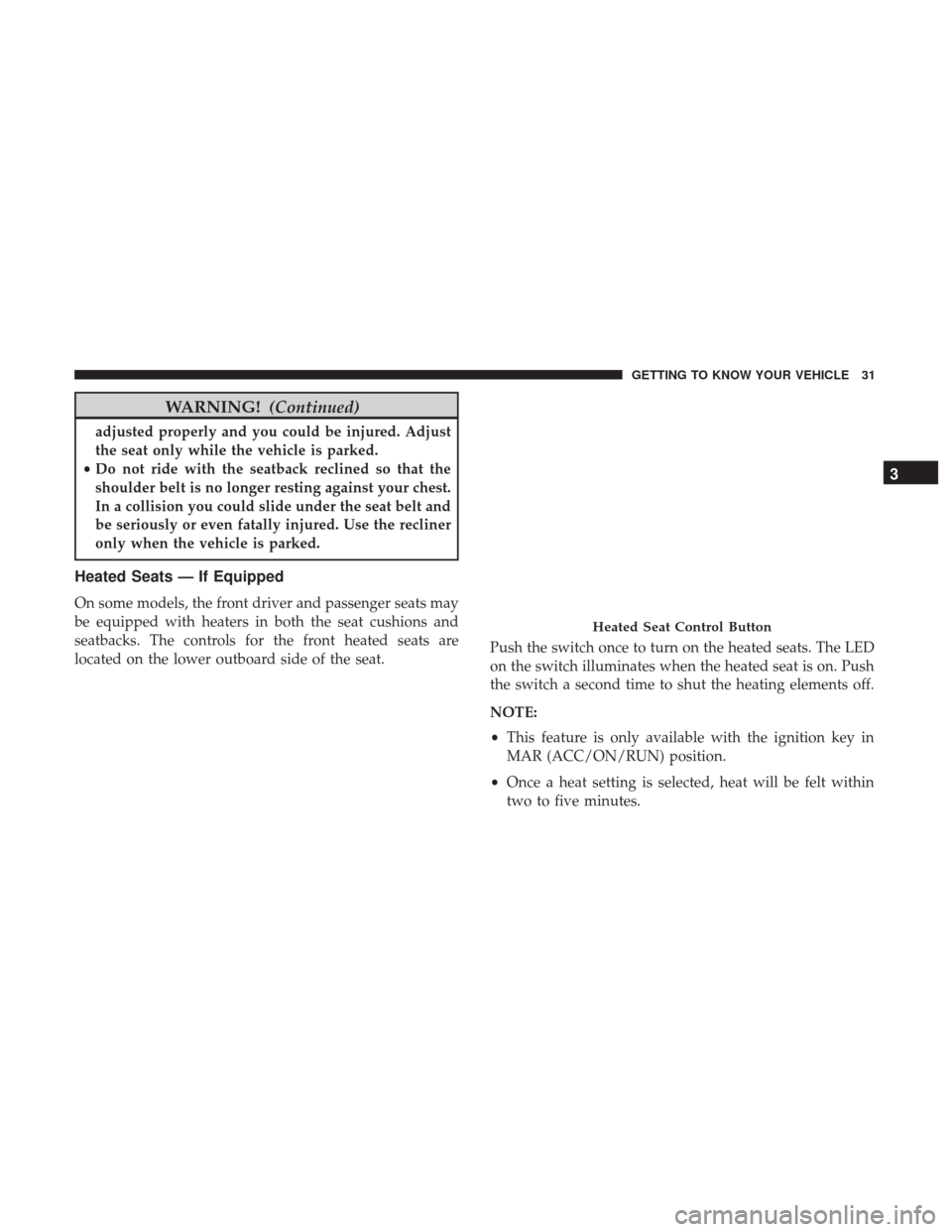
WARNING!(Continued)
adjusted properly and you could be injured. Adjust
the seat only while the vehicle is parked.
• Do not ride with the seatback reclined so that the
shoulder belt is no longer resting against your chest.
In a collision you could slide under the seat belt and
be seriously or even fatally injured. Use the recliner
only when the vehicle is parked.
Heated Seats — If Equipped
On some models, the front driver and passenger seats may
be equipped with heaters in both the seat cushions and
seatbacks. The controls for the front heated seats are
located on the lower outboard side of the seat. Push the switch once to turn on the heated seats. The LED
on the switch illuminates when the heated seat is on. Push
the switch a second time to shut the heating elements off.
NOTE:
•
This feature is only available with the ignition key in
MAR (ACC/ON/RUN) position.
• Once a heat setting is selected, heat will be felt within
two to five minutes.
Heated Seat Control Button
3
GETTING TO KNOW YOUR VEHICLE 31
Page 63 of 348
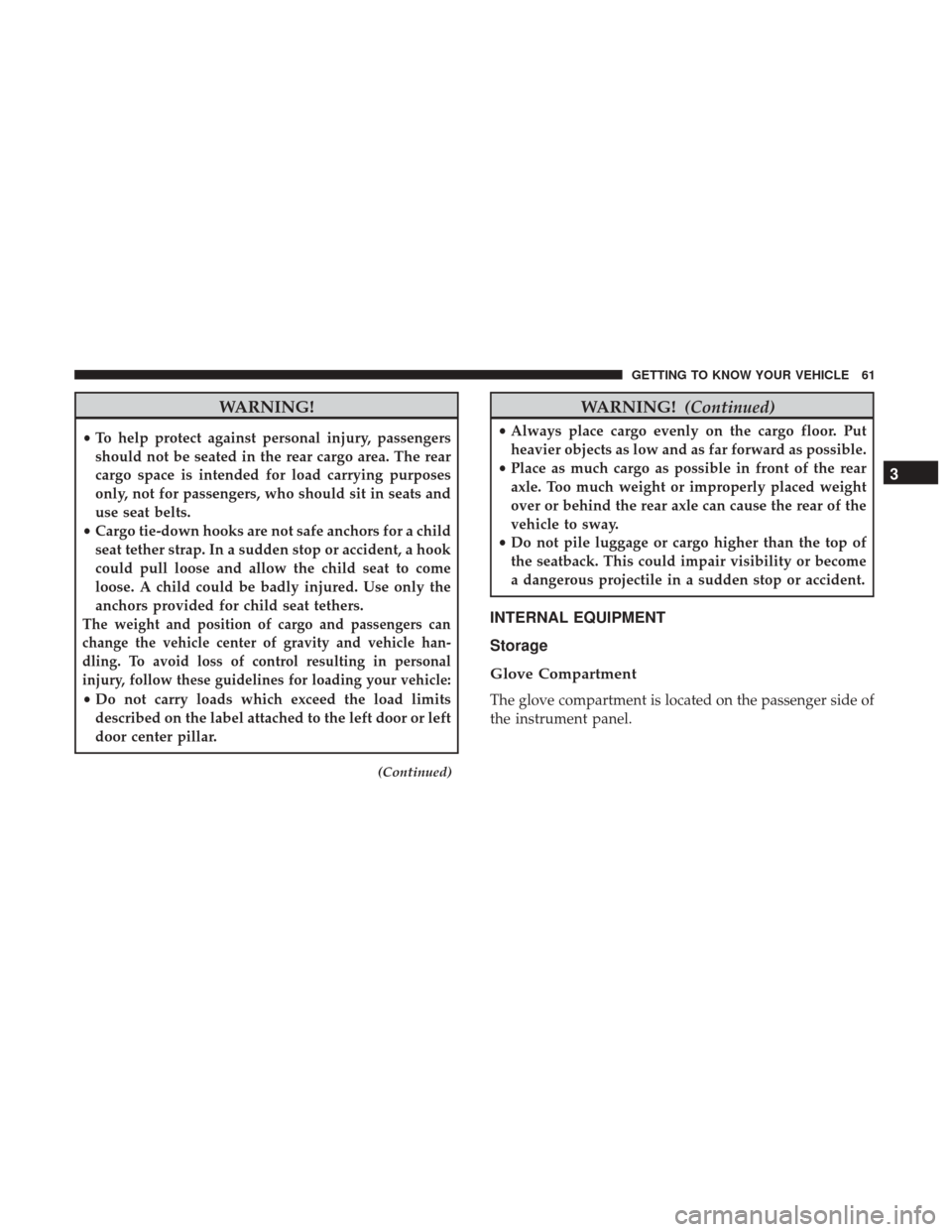
WARNING!
•To help protect against personal injury, passengers
should not be seated in the rear cargo area. The rear
cargo space is intended for load carrying purposes
only, not for passengers, who should sit in seats and
use seat belts.
• Cargo tie-down hooks are not safe anchors for a child
seat tether strap. In a sudden stop or accident, a hook
could pull loose and allow the child seat to come
loose. A child could be badly injured. Use only the
anchors provided for child seat tethers.
The weight and position of cargo and passengers can
change the vehicle center of gravity and vehicle han-
dling. To avoid loss of control resulting in personal
injury, follow these guidelines for loading your vehicle:
• Do not carry loads which exceed the load limits
described on the label attached to the left door or left
door center pillar.
(Continued)
WARNING! (Continued)
•Always place cargo evenly on the cargo floor. Put
heavier objects as low and as far forward as possible.
• Place as much cargo as possible in front of the rear
axle. Too much weight or improperly placed weight
over or behind the rear axle can cause the rear of the
vehicle to sway.
• Do not pile luggage or cargo higher than the top of
the seatback. This could impair visibility or become
a dangerous projectile in a sudden stop or accident.
INTERNAL EQUIPMENT
Storage
Glove Compartment
The glove compartment is located on the passenger side of
the instrument panel.
3
GETTING TO KNOW YOUR VEHICLE 61
Page 66 of 348
Driver And Front Passenger Power Outlets
The power outlets are located in between the driver and
front passenger seats.Load Compartment Power Outlet
The Load Compartment Power Outlet is located on the left
side of the rear cargo compartment. Depending on trim
levels, the Power Outlet location may vary.
Driver And Front Passenger Power Outlets
Load Compartment Power Outlet
64 GETTING TO KNOW YOUR VEHICLE
Page 100 of 348
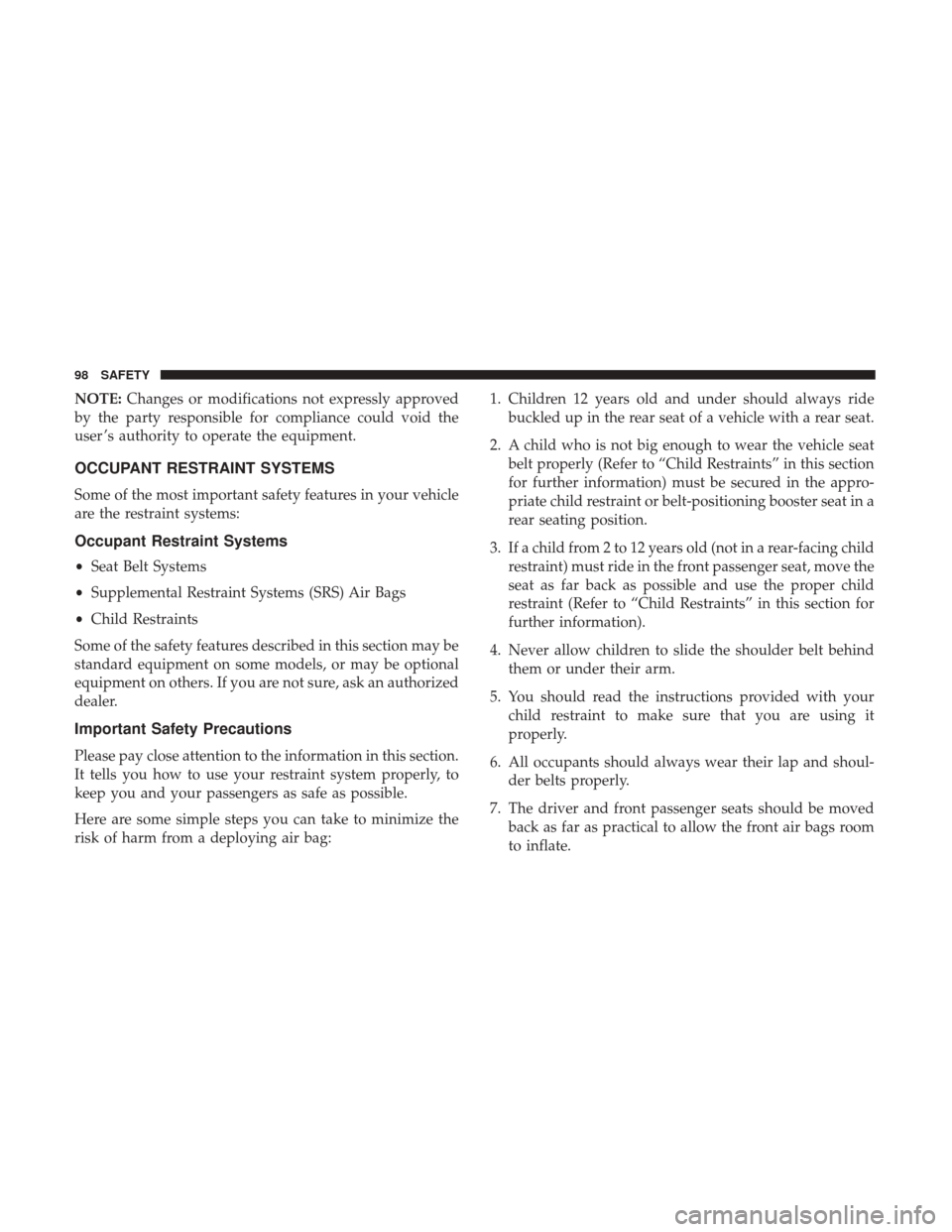
NOTE:Changes or modifications not expressly approved
by the party responsible for compliance could void the
user ’s authority to operate the equipment.
OCCUPANT RESTRAINT SYSTEMS
Some of the most important safety features in your vehicle
are the restraint systems:
Occupant Restraint Systems
• Seat Belt Systems
• Supplemental Restraint Systems (SRS) Air Bags
• Child Restraints
Some of the safety features described in this section may be
standard equipment on some models, or may be optional
equipment on others. If you are not sure, ask an authorized
dealer.
Important Safety Precautions
Please pay close attention to the information in this section.
It tells you how to use your restraint system properly, to
keep you and your passengers as safe as possible.
Here are some simple steps you can take to minimize the
risk of harm from a deploying air bag: 1. Children 12 years old and under should always ride
buckled up in the rear seat of a vehicle with a rear seat.
2. A child who is not big enough to wear the vehicle seat belt properly (Refer to “Child Restraints” in this section
for further information) must be secured in the appro-
priate child restraint or belt-positioning booster seat in a
rear seating position.
3. If a child from 2 to 12 years old (not in a rear-facing child restraint) must ride in the front passenger seat, move the
seat as far back as possible and use the proper child
restraint (Refer to “Child Restraints” in this section for
further information).
4. Never allow children to slide the shoulder belt behind them or under their arm.
5. You should read the instructions provided with your child restraint to make sure that you are using it
properly.
6. All occupants should always wear their lap and shoul- der belts properly.
7. The driver and front passenger seats should be moved back as far as practical to allow the front air bags room
to inflate.
98 SAFETY